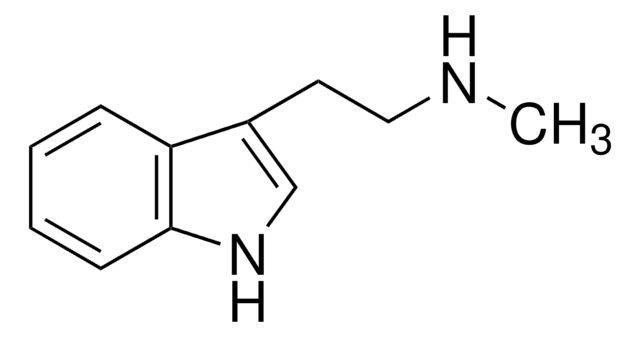SML0791
N,N-Dimethyltryptamine
≥97% (HPLC)
Sinônimo(s):
DMT, Dimethyltryptamine, N,N-Dimethyl-1H-indole-3-ethanamine
About This Item
Produtos recomendados
Nível de qualidade
Ensaio
≥97% (HPLC)
forma
powder
controle de medicamentos
USDEA Schedule I; regulated under CDSA - not available from Sigma-Aldrich Canada; psicótropo (Spain); Decreto Lei 15/93: Tabela IIA (Portugal)
cor
white to beige
solubilidade
DMSO: 15 mg/mL, clear
temperatura de armazenamento
−20°C
cadeia de caracteres SMILES
CN(C)CCC1=CNC2=C1C=CC=C2
InChI
1S/C12H16N2/c1-14(2)8-7-10-9-13-12-6-4-3-5-11(10)12/h3-6,9,13H,7-8H2,1-2H3
chave InChI
DMULVCHRPCFFGV-UHFFFAOYSA-N
Procurando produtos similares? Visita Guia de comparação de produtos
Ações bioquímicas/fisiológicas
Características e benefícios
Outras notas
Palavra indicadora
Warning
Frases de perigo
Declarações de precaução
Classificações de perigo
STOT SE 3
Órgãos-alvo
Central nervous system
Código de classe de armazenamento
11 - Combustible Solids
Classe de risco de água (WGK)
WGK 3
Ponto de fulgor (°F)
Not applicable
Ponto de fulgor (°C)
Not applicable
Certificados de análise (COA)
Busque Certificados de análise (COA) digitando o Número do Lote do produto. Os números de lote e remessa podem ser encontrados no rótulo de um produto após a palavra “Lot” ou “Batch”.
Já possui este produto?
Encontre a documentação dos produtos que você adquiriu recentemente na biblioteca de documentos.
Nossa equipe de cientistas tem experiência em todas as áreas de pesquisa, incluindo Life Sciences, ciência de materiais, síntese química, cromatografia, química analítica e muitas outras.
Entre em contato com a assistência técnica









